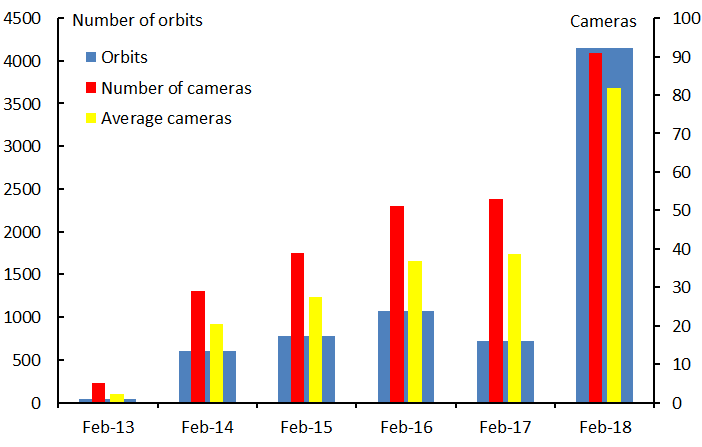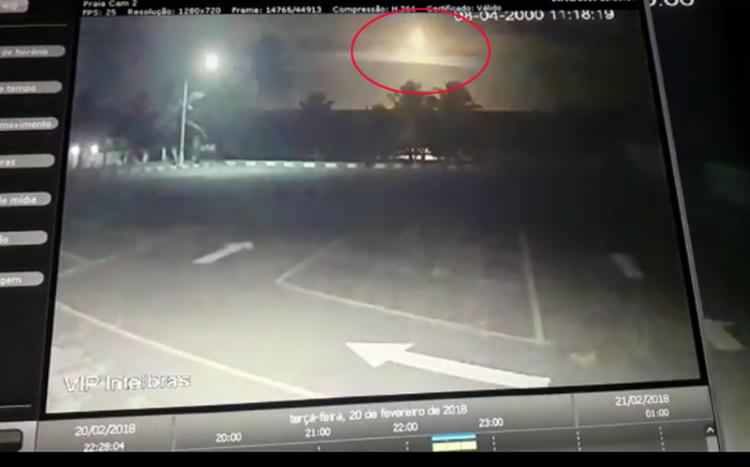1 Introduction
After two disappointing months, December 2017 and January 2018 with the most unfavorable weather possible for meteor video work, the poor weather continued the first few nights of February 2018 until a major improvement changed the situation from 5-6 February onwards. The month of February is a winter month with long nights in the BeNeLux while meteor activity is still fairly high. The weather used to be favorable during the years 2014, 2015 and 2016 when the network counted much less cameras than today. February 2017 was characterized by very bad weather circumstances with as many as 12 nights without any single orbit. What did February 2018 bring?

The night 5-6 February was the first of a long series of clear nights with every now and then a night that remained overcast. As many as 11 nights resulted in more than 200 orbits, 3 nights of these had over 300 orbits. These numbers show how rich meteor activity is this time of the year although no major showers are active.
Table 1 - February 2018 compared to previous months of February.
| Year | Nights | Orbits | Stations | Max. Cams | Min. Cams | Mean Cams |
| 2013 | 9 | 38 | 6 | 5 | 2.3 | |
| 2014 | 21 | 601 | 12 | 29 | 20.3 | |
| 2015 | 21 | 777 | 14 | 39 | 27.4 | |
| 2016 | 24 | 1075 | 17 | 51 | 13 | 36.9 |
| 2017 | 16 | 717 | 18 | 53 | 20 | 38.6 |
| 2018 | 26 | 4147 | 22 | 91 | 48 | 81.7 |
CAMS BeNeLux managed to collect 23439 meteors with 91 cameras capturing at 22 participating stations during the best nights. 12931 or 55% of these meteors were multi-station meteors, good for 4147 orbits. With the 2018 results the total number of orbits for February obtained by CAMS BeNeLux was more than doubled. With other words, February 2018 had more orbits than all previous months of February together. The statistics for February 2018 are compared in Table 1 with all previous February months since the start of the CAMS BeNeLux network. It is obvious that the numbers for 2018 are outstanding. It is very unlikely that we will have such exceptional favorable month of February ever again.
Figure 1 - Comparing February 2018 to previous months of February in the CAMS BeNeLux history. The blue bars represent the number of orbits, the red bars the maximum number of cameras running in a single night and the yellow bars the average number of cameras running per night.
On average 81.7 of the available 91 cameras were capturing per night. This high average corresponds to ~90% (89.8%) of the maximum number of cameras available which is the highest value for a month since the CAMS BeNeLux network started. Especially in the first years, before AutoCams was available in the BeNeLux, many cameras remained switched off when the weather was not good. This way the chances to obtain double station meteors for those cameras that remained active were rather small. Only 2 nights did not yield any orbit, but even during these nights some meteors were recorded. AutoCAMS kept a minimum of 48 cameras active on all nights, even on completely overcast nights. On as many as 26 nights orbits have been collected. Figure 1 shows the important increase in camera capacity. This combined with exceptional good weather explains the great success obtained in February 2018.
Comment: An increase in sky cameras and clear weather are not the only explanation for this year unprecedented meteor count, fireball activity itself is increasing: Michigan Meteor Event: Fireball Numbers Increased Again in 2017
On 2018 February 14, the CAMS BeNeLux network recorded a few similar orbits which were identified with a new minor shower listed as the February Hydrids (FHY-1032) in the IAU working list of meteor showers (Jenniskens et al., 20188). Meanwhile further searches for more orbits of this stream in public available meteor orbit listings resulted in a more detailed case study on this new shower (Roggemans and Cambell-Burns, 2018).
3 Conclusion
The efforts of the entire team of the CAMS BeNeLux network were rewarded with a record number of orbits for the month of February. The many exceptional clear nights during these long winter nights, combined with the large number of cameras and the fact that the majority of the CAMS stations switched successfully to AutoCams resulted in the best month of February ever. The many orbits obtained this month provide a lot of valuable information about the rather poorly known meteor streams active during this month. The discovery of the February Hydrids (FHY-1032) is a nice achievement for the network.
Acknowledgment
Many thanks to all participants in the CAMS BeNeLux network for their dedicated efforts. Thanks to Carl Johannink for providing all the data on which this report is based. The CAMS BeNeLux team is operated by the following volunteers:
Hans Betlem (Leiden, CAMS 371, 372 and 373), Felix Bettonvil (Utrecht, CAMS 376 and 377) , Jean-Marie Biets (Wilderen, CAMS 380, 381 and 382), Martin Breukers (Hengelo, CAMS 320, 321, 322, 323, 324, 325, 326 and 327), Bart Dessoy (Zoersel, CAMS 397, 398, 804, 805 and 806), Franky Dubois (Langemark, CAMS 386), Luc Gobin (Mechelen, CAMS 390, 391, 807 and 808), Robert Haas (Alphen aan de Rijn, CAMS 3360, 3361, 3362, 3363, 3364, 3365, 3366 and 3367), Robert Haas / Edwin van Dijk (Burlage, CAMS 801, 802, 821 and 822), Klaas Jobse (Oostkapelle, CAMS 330, 331, 332, 333, 334, 337, 338 and 339) , Carl Johannink (Gronau, CAMS 311, 312, 313, 314, 315, 316, 317 and 318), Hervé Lamy (Dourbes / Ukkel, CAMS 394 and 395/ 393), Koen Miskotte (Ermelo, CAMS 351, 352, 353 and 354), Piet Neels (Ooltgensplaat, CAMS 340, 341, 342, 343, 344 and 345, 349, 840), Tim Polfliet (Gent, CAMS 396), Steve Rau (Zillebeke, CAMS 3850 and 3852), Paul Roggemans (Mechelen, CAMS 383, 384, 388, 389, 399 and 809), Hans Schremmer (Niederkruechten, CAMS 803) and Erwin van Ballegoij (CAMS 347 and 348).
References
Jenniskens P., Johannink C. and Moskovitz N. (2018). "February Hydrids outburst (IAU#1032, FHY)". WGN, Journal of the International Meteor Organization, 46, 85-86.
Roggemans P. and Cambell-Burns P. (2018b). "February Hydrids (FHY-1032)". eMetN, 3, 128-133.




Comment: There are other signs that confirm meteor activity is on the increase, and those are the effects produced by 'meteor smoke' left in the atmosphere: SOTT Exclusive: NASA blowing meteor smoke as noctilucent clouds intensify
See also:
- Fireball above US base in Greenland puzzles NASA scientist - jokes about 'Russian strike'
- A Different Kind of Catastrophe - Something Wicked This Way Comes
- Martian Sky 'Went Metal' After Meteor Strikes
- Sott Exclusive: Meteor fireball explodes over eastern Turkey, sending shower of meteorites to the ground
- Three meteor fireballs explode in the night sky over China
And check out SOTT's: SOTT Earth Changes Summary - May 2018: Extreme Weather, Planetary Upheaval, Meteor Fireballs